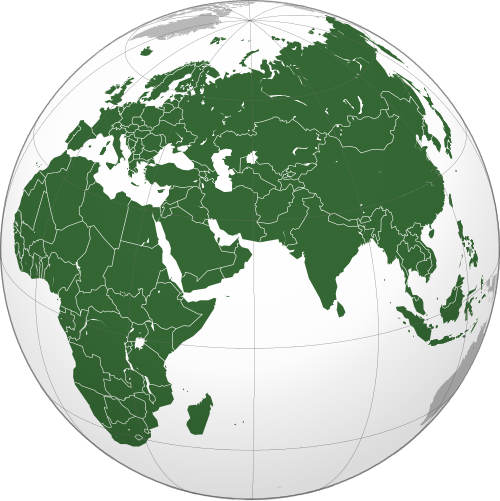Dasha Systems and the Greater Years of Planets
In ancient astrology, the seven visible “planets” were each allotted a certain number of years, which were of three types: Small, Medium, and Large. Planetary Years became an important feature of “length of life” techniques involving the hyleg and alcochoden. Here are the classical assignments derived from various sources:
YearSun MoonMercuryVenusMarsJupiterSaturnMinor1925208151230Middle69.566.5484540.545.543.5Greater1201087682667957 Image from https://en.wikipedia.org/wiki/Afro-Eurasia
Image from https://en.wikipedia.org/wiki/Afro-EurasiaThe small or minor periods are derived from recurrence cycles, at the end of which the planets conjoin the Sun at approximately the same degree of the zodiac. The Sun’s period of 19 years is its metonic cycle of 19 years, which is when an eclipse occurs in the same degree as it did at the beginning of the cycle. The Moon’s small period is based on the ancient Egyptian calendar of 365 days and the fact that 25 Egyptian years correspond to exactly 309 lunation cycles.
The greater years are not astronomically derived, but rather represent the sums of the degrees allocated to each non-luminary planet in the system of terms (bounds) used by Dorotheus (the so-called “Egyptian terms”) and also in the terms used by Ptolemy. Each zodiac sign is divided into five unequal parts, called “terms,” each of which is ruled by a different non-luminary planet.
According to Robert Hand, the Greater Years of the Sun and the Moon are not related to the terms (bounds) but rather to the apparent size of the ancient civilized world, which extended from the west coast of Africa eastward to the outer limits of Asia, so that the life-giving Sun’s maximum diurnal semi-arc was 120 degrees, equivalent to a period of 120 as its Great number of Years. Because the Moon is not visible until it is at least 12 degrees away from the Sun, the Moon was allotted 120 minus 12, or 108 degrees as its Greater number of Years.
Rob Hand speculates that this ancient tradition in Hellenistic Greece influenced the Indian dasha systems so that 120 years became the maximum lifesapn in the Vimshottari system, and the Moon’s 108 Greater Years becamse the maximum lifespan in the Ashottari system. In addition, three Yogini dasha cylces of 36 years each are equivalent to the Greater Lunar period of 108 years. Is this just coincidence, or was there an interchange of astrological lore among cultures in the ancient world?
Anthony Louis's Blog
- Anthony Louis's profile
- 29 followers



